
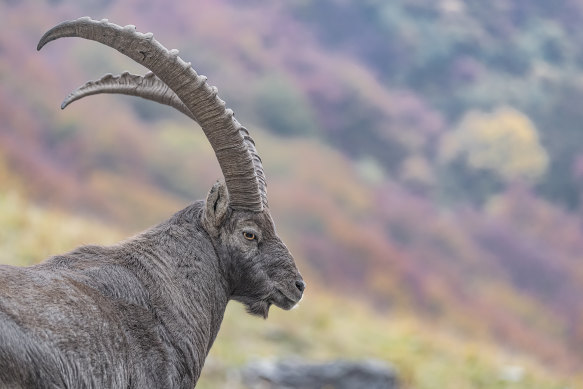
Ibex have returned to the peaks above the valley.Credit: Getty Images
The hands-off approach has clearly been rewarded. This once heavily logged area is now a thriving alpine wilderness. Lozza pulls out his high-tech binoculars to look for red deer and chamois for us, then spots an ibex high up on a ridge, shyly hiding behind a bush.
Extinct in Graubünden since 1650, the ibex in the SNP were bred from a herd owned by Italy’s King Vittorio Emmanuele III. Now the park is home to about 300 of them. We have just a moment to admire the elegant curve of its horns before it seems to sense our observation and darts away.
The last indigenous Swiss bear was shot in 1904, but Italian bears now wander over the border, their movements captured by cameras that monitor the status of the park. Other predators include wolves and lynx. In the skies, vultures and bearded eagles hover and swoop; in the forest, nutcrackers and owls are plentiful.
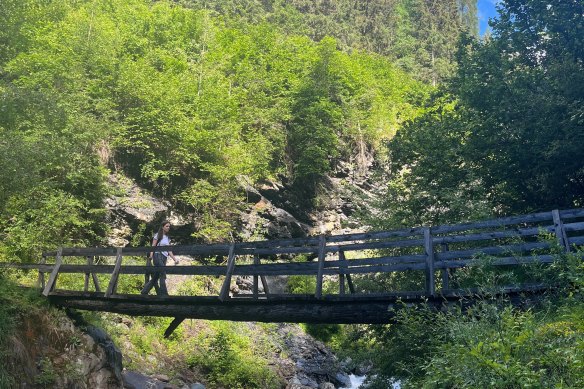
Hikers visit remote cabins or explore for sources of mineral water.
Chamanna Cluozza is the only accommodation in the SNP. A hike-in, hike-out log cabin open from mid-June to mid-October, it provides comfortable rooms, and meals made with an emphasis on local produce. To reduce transport costs, hikers with space in their backpacks are encouraged to take up goods needed for the cabin. It’s a gentle reminder that survival in the alps depends on collaboration.
Cluozza hosts, Nicole and Artur Naue and their two small sons, live in the park five months of the year. It’s a job that comes with more than just a salary. “Getting up in the morning, smelling the forest, hearing the birds and seeing the first light on the mountain peaks fills me with happiness and awe,” says Nicole.
Swiss are the main visitors here too. About 90 per cent of guests at Cluozza are nationals. “For many, the hut is associated with childhood memories from school trips, and they want to show their own children the place, the silence and nature,” says Nicole.
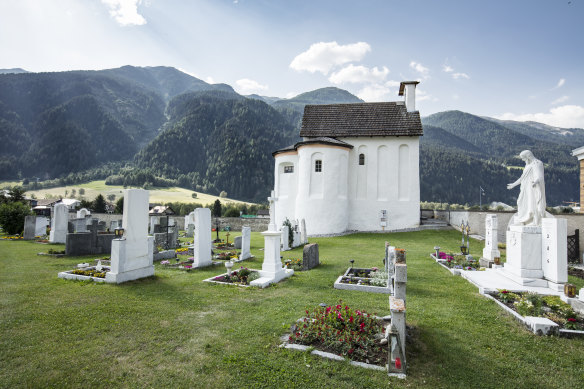
The medieval abbey of St John in the Val Mustair.Credit: Swiss Tourism
Further east, beyond the border of the park in Mustair – the Lower Engadine’s most remote outpost – there’s another kind of tranquillity. The valley feels lost in time, like a portal through the wilderness to another world. The UNESCO World Heritage-listed abbey of Saint John, an early medieval Benedictine monastery with superb examples of Carolingian art, has an austere beauty that seems appropriate for a quiet village “that doesn’t want to be a ski resort”, as one local told me.
Next door to the church, the 770-year-old Chasa Chalavaina hotel is one of Switzerland’s oldest. Once a drinking spot for the monks, it’s long been a favourite for visitors passing through the valley. After a 2022 renovation and reopening, the foundation that runs the hotel has kept its historical character while elegantly updating the amenities.
My room is like sleeping in a cosy cubby – there is a whisper of peace and quiet from original pine walls, floor and ceiling, handmade local furniture, white linen bedding and views to the town and the peaks.
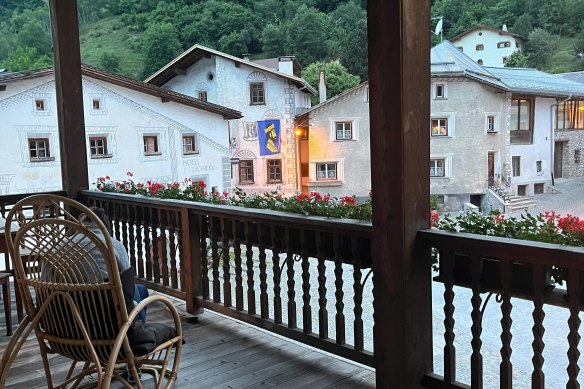
The 770-year-old Chasa Chalavaina hotel maintains its history, but adds modern comforts.
Outside, soft breezes, walking paths through meadows to the mountain, and a sky full of stars fulfil the hotel’s promise. It’s a particularly Swiss kind of luxury: simplicity, beauty and comfort without fuss.
The Val Mustair alpine biosphere, one of two such UNESCO areas in Switzerland, encompasses the valley, the SNP and parts of nearby Scuol. Forming a protective buffer zone around the park, more than 80 per cent of farms in the region are organic.
At local cheesemaking co-operative Chascharia Val Mustair, I can buy cheese, yoghurt and butter made from milk from the cows I see grazing in the meadows above the village. Unlike Australia, there’s no shortage of young people wanting to be farmers. “We have more agricultural students wanting to work on dairy farms than opportunities for them,” says Janic Fasser, Chascharia’s managing director. Looking up, it’s not hard to understand why. Who would say no to living in one of the world’s most beautiful alpine environments?
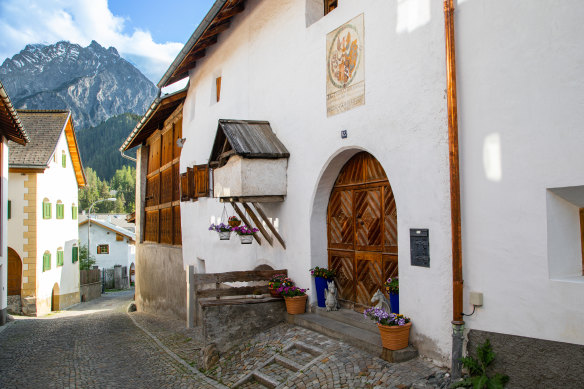
Old town section of Scuol, known for its spas.Credit: Getty Images
Scuol, on the other side of the peaks that frame the valley, was once one of the world’s most famous spa towns. It still has some elaborate 19th and early 20th century hotels that wouldn’t look out of place in a Wes Anderson movie. In the town’s historic centre, traditional farmhouses that once sheltered livestock and families alike provide a glimpse of life before the rich and famous came to “take the waters”.
In the Museum d’Engiadina Bassa – housed in one of those typical farmhouses – there are exquisite hand-embroidered textiles, intricate ironwork and more small timber-lined rooms. Painted white with delicate decorations, the farmhouse exteriors were designed to catch the light and “reflect the owners’ quiet pride in the beauty of their region”, our guide explains.
In the old town, there are free village fountains/taps that draw from more than 20 nearby mineral springs and spa holidays are still an attraction in Scuol. The Bogn Engiadina spa has many ways to experience water treatments and baths, but the town is now encouraging exploration of the sources with hikes and tours focused on mineral water. On one trail, we collect water in a cup directly from the rock; it’s naturally filtered through dolomite and the strong mineral flavour leaves our tongues tingling.
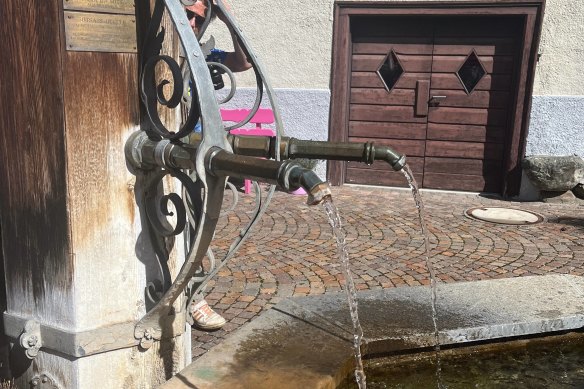
Mineral water in the fountains in Scuol is filtered through dolomite rock.
Romansch, a language with its origins in Rome, is spoken across the Lower Engadine. It’s said cattle thieves escaped up to the alps to avoid capture and stayed, embedding their language in the region. One of Switzerland’s four official languages, it’s spoken by only 0.5 per cent of the population, half of whom now live in Zurich.
In countries where hiking is simply how you get around, I’ve learned that a polite greeting to people passing on a trail is essential. In Australia, we tend to mumble a hello, if we say anything at all. In the Lower Engadine, where appreciation for the beauty of the place they live is a given, a passing “Bun di” is a joyful greeting. It’s shorthand for the universal feeling: “The world is a beautiful place, and isn’t it wonderful to be alive?”
THE DETAILS
VISIT
The Lower Engadine is reached by train from Chur and Zurich, with bus connections from Zernez to Val Mustair. See sbb.ch for timetables and tickets.
The Swiss National Park is open from mid-May to mid-November. The park centre at Zernez has detailed information about trails. Guided hikes are also available. See nationalpark.ch
FLY
Singapore Airlines has daily flights to Zurich from Perth, Melbourne, Sydney, Adelaide, Darwin and Brisbane. singaporeair.com
STAY
Check into Chasa Chalavaina, one of Switzerland’s oldest hotels, to experience the famed Swiss hospitality and local produce. See hotelchalavaina.ch
GuardaVal is a boutique hotel in a 400-year-old Engadine house in Scuol with direct access to the Bogn Engiadina spa. See belvedere-hotelfamilie.ch
Hike up to Chamanna Cluozza to experience a night in the national park.
See nationalpark.ch









 Add Category
Add Category